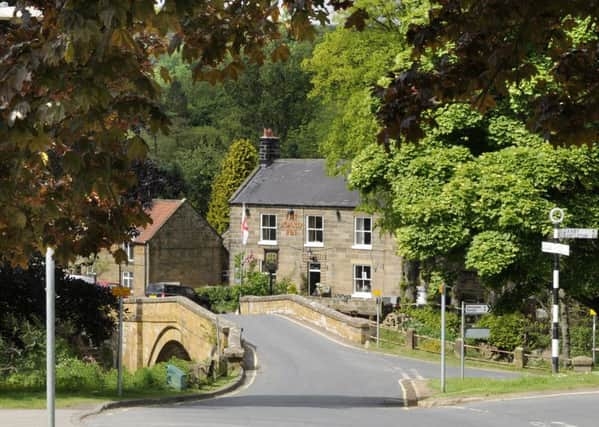Your Day Out: A charming treasure hunt


On this occasion, we chose a lovely May day mid-week to see the village itself when at its quietest.
Lealholm lies within the North York Moors National Park, about 10 miles west of Whitby, situated on a bend of the River Esk. Management of the estate was under the guidance of the late Sir Francis Ley. Much development took place, and many unusual and colourful trees planted, which you’ll admire on this local wander.
Advertisement
Hide AdAdvertisement
Hide AdVisitors are attracted not only by stunning scenery, but by its little cafes, tucked away near a well-stocked shop; galleries; nursery; post office and inn, along with stone bridge and stepping stones, wells, church and chapel, and much more!
We parked up the hill, in a car park close behind Lealholm Primary School, with public conveniences at hand. Starting from here, go up the adjacent lane, and opposite the school is a red-roofed, stone-built church with immaculate lawns and graveyard, surrounded by copper beech, oak and yew trees.
This 20th century church has a tower so small that it is only 6ft wide at the base. Standing here on the hillside, listen to bird-song and gaze down onto the houses nestling in the valley, with its green fields by the Esk, and a one-arched bridge near the spot where the river comes through a narrow gorge.
Descend the road to an information plaque seen on the green. This highlights all the interesting features to seek on your walk. There are three ornate drinking fountains around the village. Each fountain is decorated with intertwined letters of F and L, the monogram of benefactor Sir Francis Ley, the former owner of Lealholm Estate. Just cross the road to your first fountain on the green dated 1904. Notice the chained drinking mug!
Advertisement
Hide AdAdvertisement
Hide AdNext, drop down to the barrier over the roadside, to glance across to the river and green. Can you see a greenhouse to the right? This is Poet’s Cottage Garden Centre. I suggest you follow roadside pavers past the public telephone for a closer look. To your left is Beck View Tea Room, with the village store on the corner.
Go immediately left and right by cottages draped in clematis, to discover Poet’s Cottage Shrub Nursery. You may well be tempted to purchase a little treasure for your garden!
Poet’s Cottage was named after John Castillo (1792-1845) – Bard of the Dales, who also worked as a mason.
Beyond is Shepherd’s Hall Tea Rooms and Craft Gallery, and a row of terraced cottages, ‘climbing’ uphill. Opposite is an old stone step-stile, now leading to a modern, red-roofed house.
Advertisement
Hide AdAdvertisement
Hide AdFrom here, we returned briefly to the bridge, passing the garage and post office on our left. Crossing the bridge, The Board Inn featured prominently near the river bank, with menus displayed. ‘Ramblers’ Special Soup’ plus half a sandwich was priced from £5.
There followed Sophie Ann’s Attic and Original Crafts and Gifts; Stepping Stones Cottage with home-made baking and a variety of ice creams, and Stepping Stones Cottage B&B, all overlooking quoit pitches on the green.
Here, I suggest you turn immediately right to follow a good footpath descending to stepping stones across the river. You’ll find seats on the bank-side from where you may witness any calamities! (As we had our lively terrier, we went to the opposite side by the road.)
Tread with care over the excellent stepping stones to the far river bank. There you approach the Methodist Chapel which is the oldest place of worship, and celebrated its 150th anniversary in 1989.
Advertisement
Hide AdAdvertisement
Hide AdOn the side wall, near maroon-painted doors, you’ll find an interesting record of levels to which the water levels rose from river flooding on separate occasions. July 23, 1930, was the most serious, and about my shoulder height! July, 1840, was next highest, and November, 2000, about 2ft.
The Wesleyan Chapel was erected in AD 1839.
The figures on the gable ends are by Eskdale’s local poet Castillo, who lived and worked in Lealholm as a stone mason, and was also a lay preacher. Not far from this chapel is a long-disused Quaker burial ground.
Opposite the chapel’s main entrance is a second well, and near the post office you’ll find the third.
Lealholm is a sporting village, with not only a village quoits team taking part in local league matches on the village green, but a cricket and football team too. This community has also been a farming one for centuries.
Advertisement
Hide AdAdvertisement
Hide AdDuring the 1920s, the quarrying of ganister above Lealholm-side brought more trade to the village. The ganister was pulverised and made into silica bricks. These were used as furnace linings for steel making.
Enjoy this simply delightful village, with so much to see and do, it’s like a treasure hunt! We’ll most certainly return to explore further.
Distance of walk: As long as you wish to make it.
Refreshment: The Board Inn and several cafes and shop.
Toilets: The Board Inn and car park.
Location: About 10 miles west-south-west of Whitby, and one hour’s drive from Scarborough.